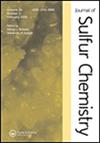生物活性有机二硫代氨基甲酸酯合成方法的最新进展
IF 1.6
3区 化学
Q3 CHEMISTRY, MULTIDISCIPLINARY
引用次数: 0
摘要
二硫代氨基甲酸酯具有广泛的化学用途和药用价值,在农业、化学合成和环境修复等领域发挥着重要作用。然而,自20世纪30年代以来,二硫代氨基甲酸酯主要被用作农药和作物保护的杀菌剂。最近,二硫代氨基甲酸酯从农用化学品到治疗癌症和微生物感染等危及生命的疾病的重新用途药物的复兴,刺激了药物化学家重新研究它们未被满足的潜力。此外,含有多种有机功能的二硫代氨基甲酸酯对真菌抗性植物病原体显示出良好的抗真菌活性,为解决真菌抗性的全球威胁提供了解决方案。因此,利用不同的有机底物合成多层S和n功能化有机二硫代氨基甲酸酯在合成和药物化学研究中重新浮出水面。有机二硫代氨基甲酸酯的合成也越来越趋向于开发更方便的合成方法,这些方法具有各种绿色化学方面的特点,包括替代或可再生能源、绿色溶剂、无溶剂反应条件和成本效益。这些更环保的方法也与高效率、更好的选择性、广泛的底物范围、出色的产量、操作简单和可行性有关。本文综述了近年来制备新型有机二硫代氨基甲酸酯的各种合成途径的最新进展,包括涉及胺、二硫化碳和各种有机底物反应的多组分合成方法。本文还全面讨论了利用市售的无害的四烷基硫脲二硫化物或单硫化物作为有机前体直接合成s -烷基和s -芳基二硫氨基甲酸酯的新方法。本综述还重点介绍了最近开发的使用替代反应物代替二硫化碳或二硫化硫的非常规绿色方案。本文章由计算机程序翻译,如有差异,请以英文原文为准。
Recent advances in synthetic approaches for biologically active organic dithiocarbamates
The chemically and medicinally versatile dithiocarbamates play a significant role in advancing various fields, including agriculture, chemical synthesis, and environmental remediation. However, dithiocarbamates have primarily been utilised as pesticides and fungicides for crop protection since the 1930s. Recently, the revival of dithiocarbamates from agrochemicals to repurposed drugs for treating life-threatening diseases like cancer and microbial infections has stimulated medicinal chemists to reinvestigate their unmet potential. Furthermore, dithiocarbamates containing diversified organic functionalities have shown promising antifungal activity against fungal-resistant phytopathogens, offering a solution to addressing the global threat of fungal resistance. Consequently, the synthesis of multifaceted S and N-functionalized organic dithiocarbamates using diverse organic substrates has resurfaced in synthetic and medicinal chemistry research. There is also a growing trend to develop more convenient synthetic approaches for synthesising organic dithiocarbamates featuring various green chemistry aspects, including alternative or renewable energy resources, green solvents, solvent-free reaction conditions, and cost-effectiveness. These greener approaches are also associated with high efficiency, better selectivity, broad substrate scope, outstanding yields, operational simplicity, and viability. This review provides an in-depth overview of the recent developments in the diverse synthetic routes for preparing novel organic dithiocarbamates, including multi-component approaches involving the reaction of amines, carbon disulfide, and a wide range of organic substrates. The emerging methodologies for directly synthesising S-alkyl and S-aryl dithiocarbamates using commercially available and non-hazardous tetraalkylthiuram disulfides or monosulfides as organic precursors are also comprehensively discussed in this article. This review also highlights recently developed unconventional greener protocols using alternative reactants instead of carbon disulfide or thiuram disulfides.
求助全文
通过发布文献求助,成功后即可免费获取论文全文。
去求助
来源期刊

Journal of Sulfur Chemistry
CHEMISTRY, MULTIDISCIPLINARY-
CiteScore
4.10
自引率
9.10%
发文量
38
审稿时长
6-12 weeks
期刊介绍:
The Journal of Sulfur Chemistry is an international journal for the dissemination of scientific results in the rapidly expanding realm of sulfur chemistry. The journal publishes high quality reviews, full papers and communications in the following areas: organic and inorganic chemistry, industrial chemistry, materials and polymer chemistry, biological chemistry and interdisciplinary studies directly related to sulfur science.
Papers outlining theoretical, physical, mechanistic or synthetic studies pertaining to sulfur chemistry are welcome. Hence the target audience is made up of academic and industrial chemists with peripheral or focused interests in sulfur chemistry. Manuscripts that truly define the aims of the journal include, but are not limited to, those that offer: a) innovative use of sulfur reagents; b) new synthetic approaches to sulfur-containing biomolecules, materials or organic and organometallic compounds; c) theoretical and physical studies that facilitate the understanding of sulfur structure, bonding or reactivity; d) catalytic, selective, synthetically useful or noteworthy transformations of sulfur containing molecules; e) industrial applications of sulfur chemistry; f) unique sulfur atom or molecule involvement in interfacial phenomena; g) descriptions of solid phase or combinatorial methods involving sulfur containing substrates. Submissions pertaining to related atoms such as selenium and tellurium are also welcome. Articles offering routine heterocycle formation through established reactions of sulfur containing substrates are outside the scope of the journal.
 求助内容:
求助内容: 应助结果提醒方式:
应助结果提醒方式:


